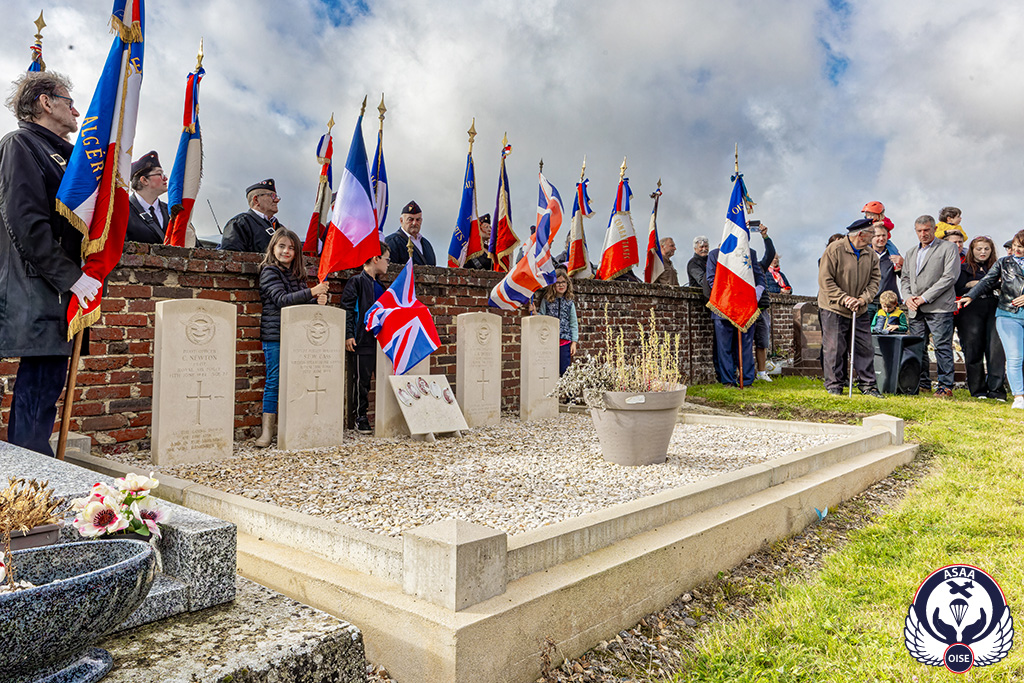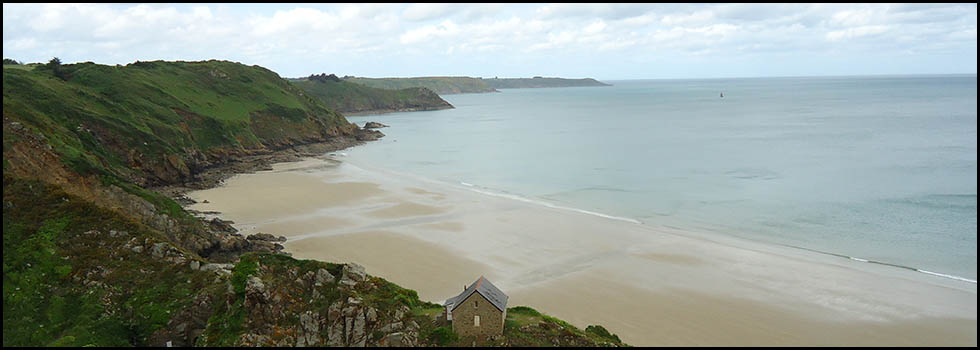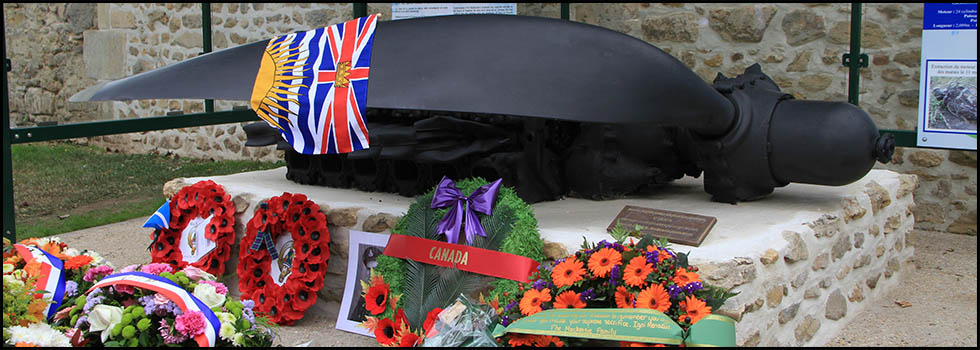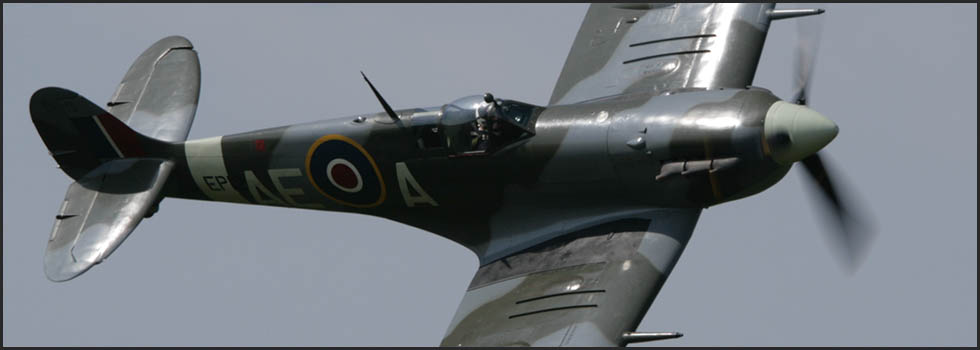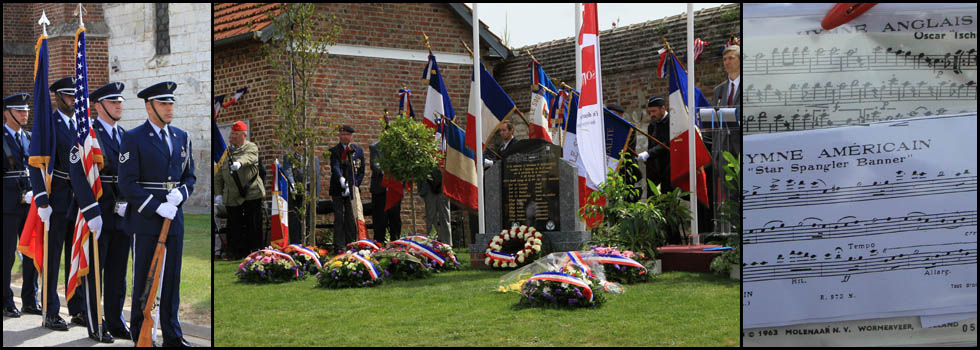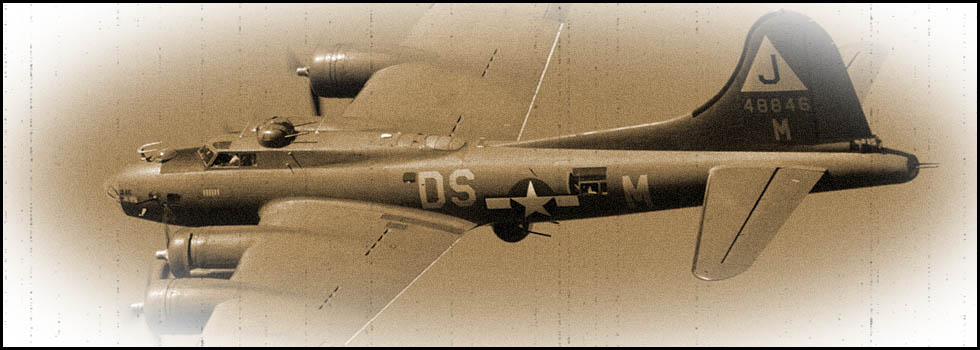27 September 2025
Ceremony in memory of the crew of Avro Lancaster ND 681,
RAF 100 Squadron
Bonneuil-les-Eaux (Oise)
Copyright © 2025 - Association des Sauveteurs d'Aviateurs Alliés- All rights reserved -
En français ![]()
After paying tribute to the crew of Short Stirling BK653, this second ceremony took place near the crash site of Lancaster ND681, shot down during the night of 15th to 16th March 1944.

The memorial stone was unveiled by elected officials and, as earlier in the day, our Association recounted the history of this night mission and the tragic fate of the seven crew members who lost their lives in this small village in northern Oise.


Wreaths were laid near the memorial. Then came the Last Post, a minute's silence followed by the Canadian, British and French national anthems.


The Bonneuil-les-Eaux brass band

The day of tribute continued in the courtyard of the town hall. Elected officials and authorities took turns speaking, each reminding the audience of the necessary duty of memory, emphasising the importance of passing this on to the younger generation so that we never forget these young airmen who, like so many others, had come from distant countries to fight, often sacrificing their lives, so that we could live in a free country.

Ms Nadège Lefèbvre, President of the Oise Departmental Council

Mr Arnaud Guiniou, Sub prefect
After the dignitaries thanked the representatives of the veterans, this magnificent day ended with a convivial drink.


27 September 2025
Ceremony in memory of the crew of Short Stirling MkIII BK653
RAF 214 Squadron
Bonneuil-les-Eaux (Oise)
Copyright © 2025 - Association des Sauveteurs d'Aviateurs Alliés - All rights reserved -
En français ![]()
On 27 September, on the initiative of the Communauté de Communes de l'Oise Picarde and the Hauts-de-France region, two memorial stones were unveiled in tribute to Royal Air Force bomber crews in the village of Bonneuil-les-Eaux.
The first ceremony took place near the crash site of the Short Stirling BK653, RAF 214 Squadron, shot down on the night of 16th to 17th April 1943.
In the presence of a large crowd, including local and regional authorities, flag bearers of patriotic Associations and the Bonneuil-les-Eaux brass band, Ms Nicole Cordier, departmental councillor and mayor of the village, began the tribute with a welcome speech, thanking those present for attending.

The memorial stone was then unveiled.

Our Association then recounted the history of this mission on the night of 16th to 17th April 1943 and the fate of each of the crew members. The names of the many courageous families from the surrounding towns and villages who helped the five escaped airmen by sheltering them and escorting them on their way to freedom were recalled.

This was followed by the laying of wreaths at the foot of the memorial, the sounding of the Last Post, a minute's silence and the Canadian, British and French national anthems.



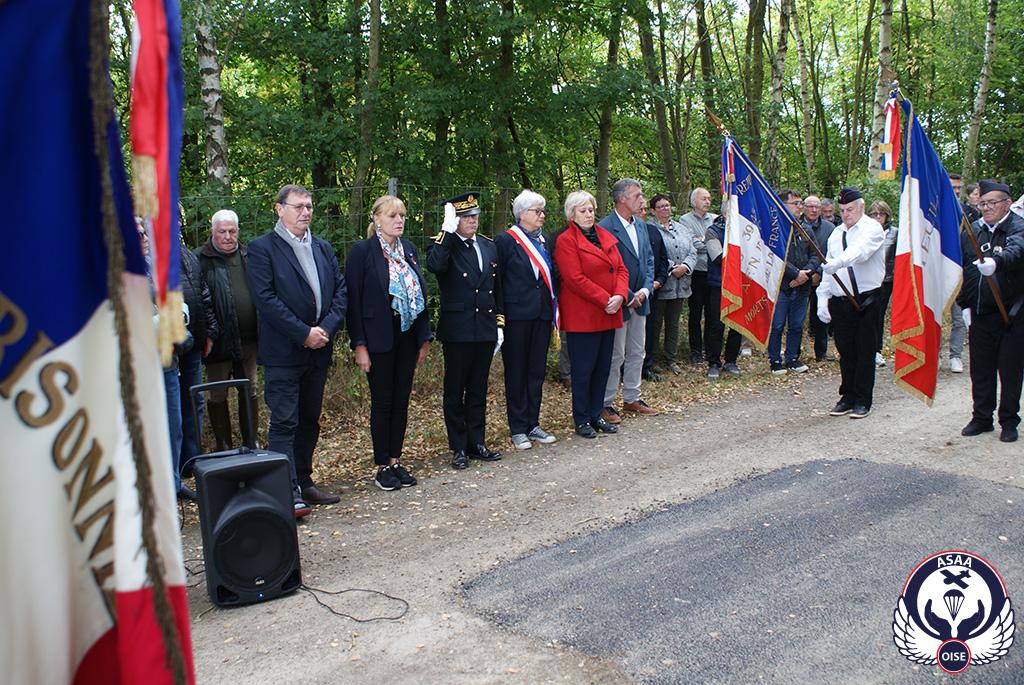
Once the ceremony was over, all those present were invited to proceed to the site of the second commemoration to pay tribute to the crew of Lancaster ND681, RAF 214 Squadron, which crashed in March 1944.
13th September 2025
Ceremony in memory of the crew of B-17G # 42-31388
306th Bomb. Group
423rd Bomb. Squadron
8th Air Force
Campremy (Oise)
Copyright © 2025 - Association des Sauveteurs d'Aviateurs Alliés - All rights reserved -
En français ![]()
On the initiative of the Hauts-de-France Region and the Communauté de Communes de l'Oise Picarde, two ceremonies were held in the commune of Campremy in memory of two American bomber crews shot down during the Second World War. The first tribute took place on the very spot where, on February 11, 1944, Boeing B-17G # 42-31388 of the 306th Bomb. Group crashed while returning from a bombing mission over Frankfurt, Germany.


Of the 10 crew members, 6 managed to escape thanks to the French Resistance, while 3 were taken prisoner. Only S/Sgt. James Coleman lost his life. He is still missing in action to this day.
S/Sgt. Leonard Bergeron, left waist gunner, was one of the survivors. He was taken in by the Resistance and then by the Shelburn escape network. He managed to reach England by sea 5 weeks later, after having been sheltered in Clermont and Creil in the Oise region, then in Paris, and finally in Brittany.
During the ceremony, we were honored to welcome his descendants from Connecticut and Florida : Stephen, his son, Thomas and Kate, his grandson and granddaughter, accompanied by their respective wives and husbands. Also among us was Jean-Marc, representing his grandmother Odette Sauvage. She had hosted S/Sgt. Leonard Bergeron in Clermont for a week.

The Bergeron family
The ceremony began with a speech by Mr. Commelin, mayor of the village. After warmly thanking the Bergeron family for their presence, he declared:
"It's not without a certain emotion that I welcome you to our land, to retrace a page in our history, and above all to pay tribute to those who came to fight alongside us to defend our values, our freedom... We owe it to ourselves to pay tribute to all these young soldiers who came to fight alongside us to defend our freedom, which, today more than ever, is very dear to us.

We also have a duty to pass on this history to the young, to bring home to them the reality of war, to remind them of the suffering endured, but also to show them the strength of courage and hope. It is through this living memory that we can build a future of peace and fraternity.
This mission of transmission is all the more essential as the world continues to experience conflicts. Particularly on Europe's doorstep, between Ukraine and Russia, and in the Middle East between Israelis and Palestinians. People are still suffering the pain of war. These tragedies remind us that peace remains fragile and must be defended every day.
I'd like to conclude by saying that it's important to know one's past, not to forget it, and to pass it on, so as to avoid making the same mistakes again".
Thomas and his sister Kate then unveiled the stele commemorating the crew on which their grandfather served.

The mission of February 11, 1944 and the fate of the crew were then recounted by our Association. The names of local families who came to the aid of the escapees were listed.
Thomas Bergeron then took his turn to speak:
"Thank you for all being here today to honor the airmen of the Allied forces who fell from the sky here so many ago. Their bravery and sacrifice have in pursuit of liberty and freedom for the people of France is matched only by the citizens of Oise who risked their lives to liberate the liberators. I am living proof of the bravery and kindness of the French people. Leonard Bergeron, my grandfather, was shot down and taken in with open arms by Odette sauvage and this communauty. He was then hidden from the germans for several weeks and ultimately reunited with US forces in Britain.

After the war, my grandfather went on to have 8 children, 10 grandchildren and 16 great grandchildren while living a full and happy life. That is 34 lives that never would have been if it was’nt for the bravery shown by your community.
My family is forever grateful to the people of France and all of you here today for preserving this piece of history, as it would never be forgotten.
Thank you, my Gof bless America and vive la France".
This was followed by the laying of wreaths at the stele, the Last Post and a minute of silence...
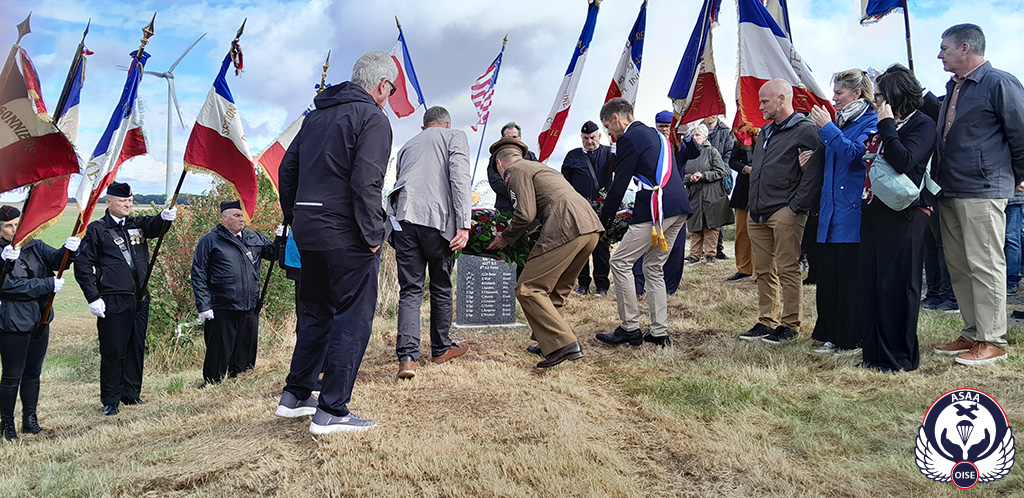

......... followed by the American and French national anthems.




At the end of the ceremony, the entire audience moved on to the crash site of another Boeing B-17 shot down over Campremy territory on December 30, 1943.
To conclude the day's events, which included the unveiling of three steles in Thieux and Campremy, everyone gathered in the village hall in Campremy for a convivial moment. Elected representatives from the Département and the Région took turns to speak, reminding us of the importance of the duty of remembrance, of remembering the Allied airmen from distant countries who fought far from home, often at the price of the greatest sacrifice, so that we could live in a free country.


13 September 2025
Ceremony in memory of the crew of B-17F # 42-30674 "Destiny's Tot"
95th Bomb. Group
336th Bomb. Squadron
8th Air Force
Campremy (Oise)
Copyright © 2025 - Association des Sauveteurs d'Aviateurs Alliés- All rights reserved -
En français ![]()
This ceremony was held near the crash site of Boeing B-17F # 42-30674 “Destiny's Tot” of the 95th Bomb. Group, to pay tribute to its crew.
This bomber was shot down on December 30, 1943, returning from a mission over Ludwigshafen, Germany, to bomb the chemical industries and port facilities.
The stele was unveiled by elected representatives of the Hauts-de-France Region, the Conseil Départemental de l'Oise and the Communauté de Communes de l'Oise Picarde.

The ceremony continued with a review of the events of the mission on December 30, 1943. The 10 crew members managed to evacuate the stricken aircraft before it crashed in a field near the village. All the crew survived. Seven managed to escape under cover of the Alsace escape network based in Oise, then Shelburn and also Burgundy escape lines. Seriously wounded, three were taken prisoner. The names of the many families in our region who gave assistance and shelter to the escaped airmen, at enormous risk, have been mentioned.

Although informed, the descendants of 2nd Lts Booher, Feingold and Tarkington were unable to make the trip from the USA to attend this commemoration in memory of their fathers. However, on the other side of the Atlantic, their thoughts were with us on this special day.
Wreaths were laid at the foot of the stele, followed by the American and French national anthems.





This magnificent day came to a close at the village hall in Campremy with a convivial drink. To conclude, elected representatives from the Département and the Région took turns to speak, reminding us of the importance of the duty of remembrance, of remembering the Allied airmen from distant countries who fought far from home, often at the price of the greatest sacrifice, so that we could live in a free country.


13 September 2025
Ceremony in memory of the crew of Halifax LW675
RAF 578 Squadron
Thieux (Oise)
Copyright © 2025 - Association des Sauveteurs d'Aviateurs Alliés- All rights reserved -
En français ![]()
On 13 September, a series of commemorations in memory of several Allied bomber crews took place at the initiative of the Hauts-de-France Region and the Communauté de Communes de l'Oise Picarde.
The first commemoration was held in the commune of Thieux, at the very spot where the Halifax LW675, RAF 578 Squadron, crashed on the night of 12 to 13 June 1944.
Welcomed by Mrs Guigot, mayor of the village, in the presence of a large crowd surrounded by elected officials from the region and the department, as well as representatives of patriotic associations, a memorial stone was unveiled at the crash site. Our Association recounted the history of the mission and the tragic end of some of the crew members. We were honoured by the presence of descendants of the Bertin, Martin and Delamare families. At the time, these families had come to the aid of the two survivors of the bomber, despite the risks involved. Also among us were a few elders from the village who have always remembered this tragedy after visiting the crash site the next day when they were just young children.


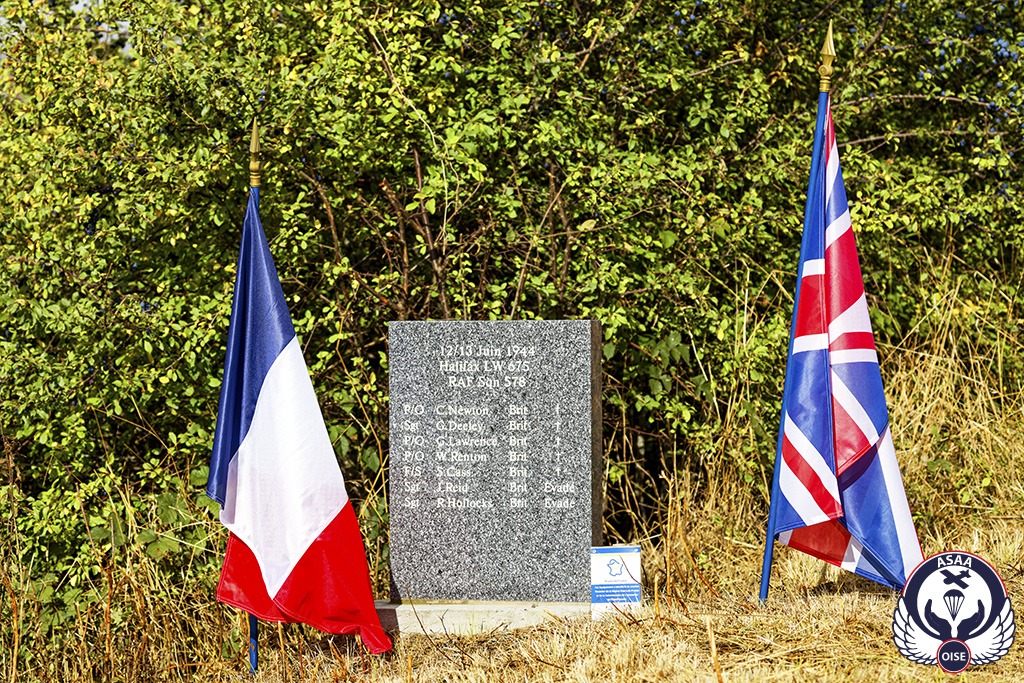
The memorial stone engraved with the names of seven British airmen will now serve as a reminder of their sacrifice for our freedom.
The entire procession then made its way to the village cemetery where the five crew members who perished are buried. Surrounded by her family, we had the honour of welcoming 93-year-old Mrs Huguette Noblecourt, the only surviving witness to the presence of the two rescued airmen when they were staying with her parents (the Martin family) in Thieux.
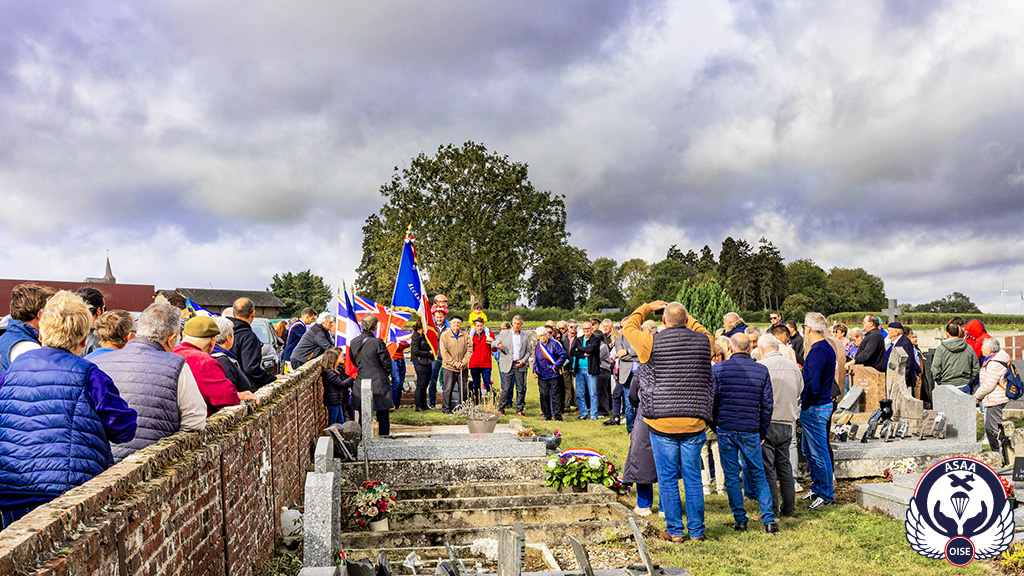

Mrs Huguette Noblecourt, centre.
Wreaths were laid on the graves. After the Last Post and a minute's silence, the British and French national anthems were played. The ceremony ended with the flag bearers saluting in front of the graves.
